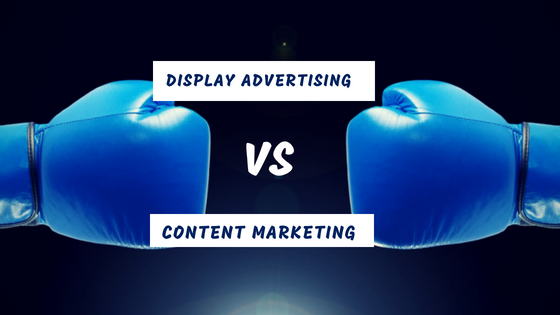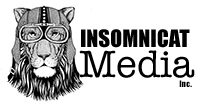Display Ads Vs. Content Marketing
As its name suggests, display advertising is a much more visual approach to marketing your product or brand. The medium relies heavily on elements like images to communicate a message. The first banner ad displayed on the web in 1994 on HotWired, the first commercial web magazine, and online banner ads were even used by online services COCONET and PRODIGY back in 1988. Since then, this approach to marketing has buried deep in the hearts of marketers.

Just because your advertisement is featured on a website doesn’t mean it’s a display ad though (think banner ads placed on specific sections of a site purchased by clients with the intent of generating quick conversions). Some of the most common display-ad sizes out there are 336 x 280, 300 x 250, 728 x 90, and 320 x 110. Other forms of display advertising (and arguably more disruptive) include interstitial and overlay ads.
While display ads are obviously more “in-your-face” than alternatives like native ads and content marketing, one of the reasons marketers opt for this form of advertising is cost-effectiveness (many agencies offer low CPM rates) and measurement opportunities.
One of the growing trends in display advertising is programmatic display advertising.
eMarketer had predicted programmatic display spending near $33 billion in 2017. This tactic allows advertisers to automate the buying of digital ads by using machines and big data to target ads on relevant websites using characteristics such as age, interests, jobs, and recent browsing history.
While you may be able to build brand awareness and reach larger numbers of potential buyers, as well as target specific demographics, marketers also find lower click-through-rates (CTR) and conversions using this method, when compared to other advertising forms.
In addition, there are also a variety of ad-blocking tools that can prevent people from seeing your ads. Ad blocking is changing the way digital marketers behave. It poses a major challenge. The best way for the industry to tackle the problem is to deliver compelling ad experiences that people don’t want to block.
According to a report published by PageFair earlier this year, 615 million devices now use Adblock. Adblock usage grew 30% globally in 2016.
Now think about content marketing as an alternative– an option that allows marketers to promote brands and products via digestible and informative materials such as articles, white papers, videos, case studies, and eBooks in order to build relationships in today’s digital marketplace. Remember, content is really anything — from information like facts and figures to experiences that leave an impression on a user.
This strategy is a more long-term approach with benefits such as brand awareness, trust, and greater reach at a lower cost. As you create more content for consumers to interact with, your brand becomes more visible on the Internet as people search for answers to their related questions. While this is not a “one-and-done” method, the long-term benefits are plentiful.
For starters, you’ll likely be producing a lot of content, which lends a hand to higher visibility in search engines and an increase in domain authority. If you use your content correctly, you’ll also have an opportunity to expand your social presence and gain more followers there. As previously mentioned, it’s a great way to raise brand awareness and develop strong relationships with customers. As your content gently encourages users to move along in the buying process, no matter where they currently stand, you will also see an increase in conversions.


Leave a comment